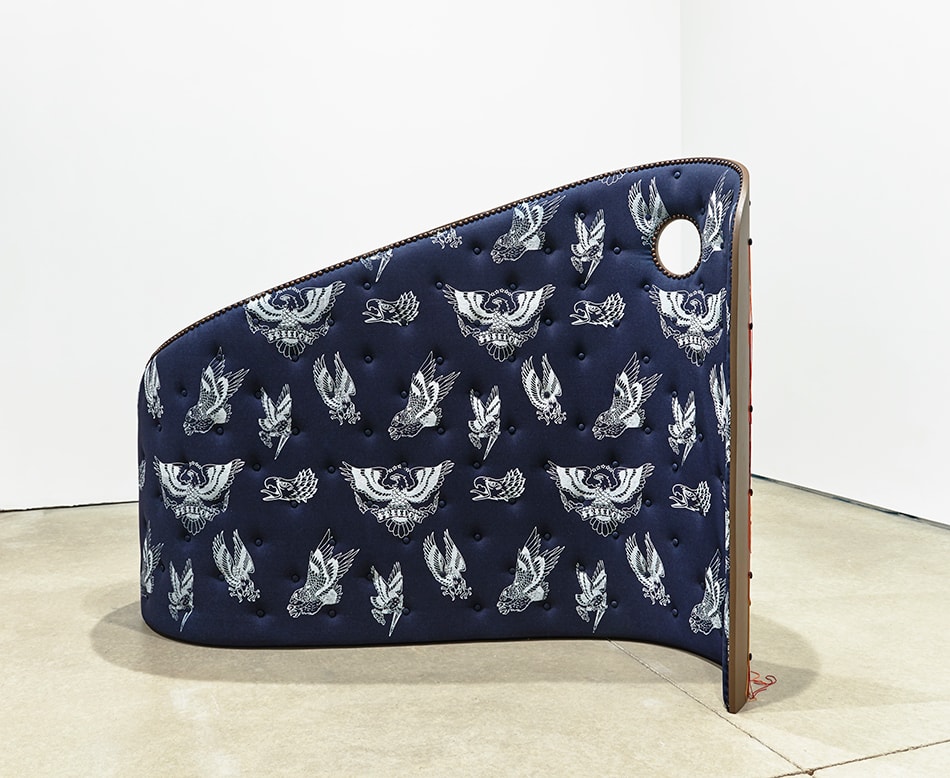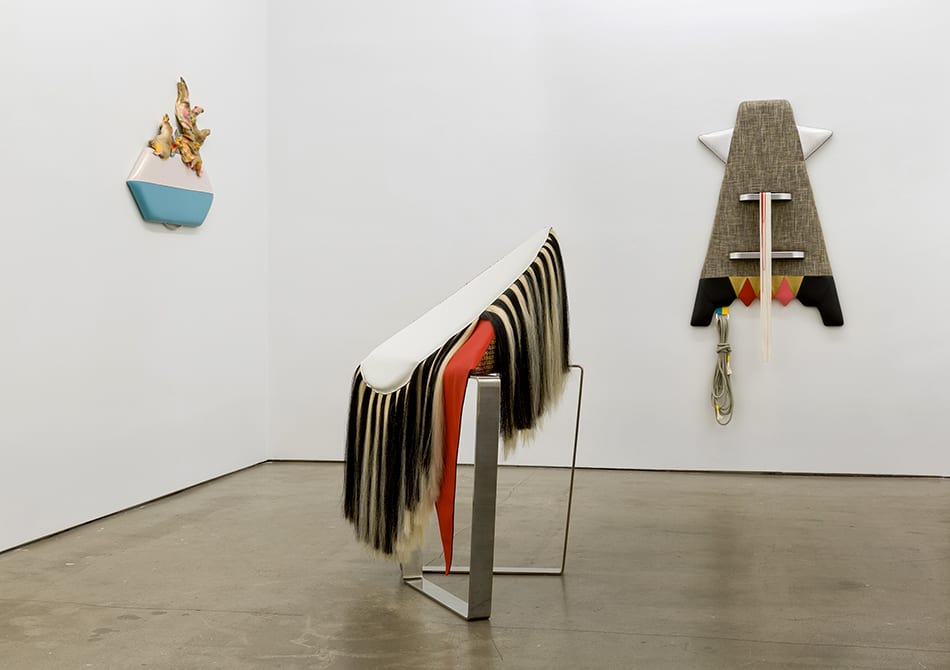
Trish Tillman, Double Foxhole, 2018, hand-printed denim, wood, tassels, hardware and foam. The title of the work references a letter Tillman's grandfather wrote to her grandmother while he served during World War II. The piece's opposite side, not visible here, features "hundreds of colorful, dangling tassels," Tillman says.
The sculptural work of Trish Tillman (MFA 2009 Fine Arts)—the latest of which will be on view at "Shore Leave," her upcoming solo exhibition at fellow MFA Fine Arts alumnus Asya Geisberg's Manhattan gallery from November 7 through December 20—balances beauty and power. This is most immediately evident in the materials she uses, from opulent leather and vinyl, to sterile and shiny chrome, to soft and refined household items. The work's inspiration, too, is a balance: between masculine and feminine decorative tropes, the private and the public, happy memories and personal traumas.
"Tillman's work vacillates between the wonderment and 'simpler times' of childhood and the harsh realities of growing up," art professional Melissa Messina wrote in a catalog essay for "Remains (to be Seen)," Tillman's 2018 exhibition at the Visual Arts Center of Richmond, Virginia. "She presents these works from the precipice of reflection, a place of looking back in order to cope with life-changing moments and determining how to best more forward productively."
Tillman herself describes her art in a number of different but related ways. She begins a sculpture by sketching out shapes, then determining a color palette and the overall mood she wants to evoke. When her works are in their early stages, she views them as vacant houses—to be occupied and then invested with all the ups, downs, dramas and safeties of home life—or as "personal altars," or "memorabilia that represents something else in a distilled manner. … They become symbols for our human condition that explore family and personal dynamics and how we relate to one another."
Inspiration for Tillman's recent work has come from her extensive travel in Asia over the past few years—in particular, her appreciation for the region's rich architectural and decorative traditions—and her love of the "lush interiors" of bars and cafés, as well as the luxe materials and construction of handbags. The visual and tactile appeal of these surfaces, ornaments and details—with all their implications of the unattainable or the ideal—act as her sculptures' "flashy outer presence, like a mask or a shield, [or] as a way that we present ourselves," she says. "Almost like applying makeup."
Conversely, hand-me-down fabrics—such as dish towels once owned by her grandmother and held on to for nearly 20 years following her death, or secondhand sheets—have added a more inward-looking, domestic and personal aspect to her art. Other, non-fabric objects used in her constructions include horsehair, metal studs and buckles, toothbrushes and candy dishes. Depending on the object, it might reference Tillman's own biography or just exist to add a winking, "flirty and fetish" element.
"For a while, I felt bad for having fun while I worked," she says, "but I go back and forth between making serious work and wanting to express something genuine."
Tillman grew up as a tomboy in Washington, DC, where she was drawn to the area’s punk and metal music scene, with its studs, leather and male-dominated culture. She earned her BFA from James Madison University, in Virginia, before enrolling at SVA. As a young child, she was a victim of sexual assault, and this experience has influenced her work, especially as of late.
"I've always been soft-spoken about my history of sexual violence, but I think that the work is bringing that out more these days." Recent pieces enact a sort of reclamation, she says, by "taking back the idea of who gets to impose power on another person." With their visual allusions to armor and in their immaculate construction, her sculptures exude confidence, poise and strength. But they also are the product of personal upheaval and self-inquiry.
"I started to think about how I am sewing up all this stuff into a beautiful façade," she says, the physical labor mirroring the mental process of confronting the darker episodes of her past. "It's been really healing for me to make this work. The work, to me, is not about just exposing a bunch of stuff, it's about getting past that and figuring out how to forgive."
"Growing and changing is really uncomfortable," she adds. "So the work, I think, has to really have both of those things in order to explore the dichotomy of humanity."
Tillman's work has been exhibited in numerous solo and group exhibitions throughout the United States. She is represented by the Asya Geisberg Gallery in New York City. She is a recipient of the Joan Mitchell Foundation 2009 MFA Grant and participated in the Visual Arts Center of Richmond residency program in 2018, as well as the Kala Chaupal residency in Jaipur, India. For more information, visit trishtillman.com.
A version of this article appears in the fall/winter 2019 edition of the Visual Arts Journal.



